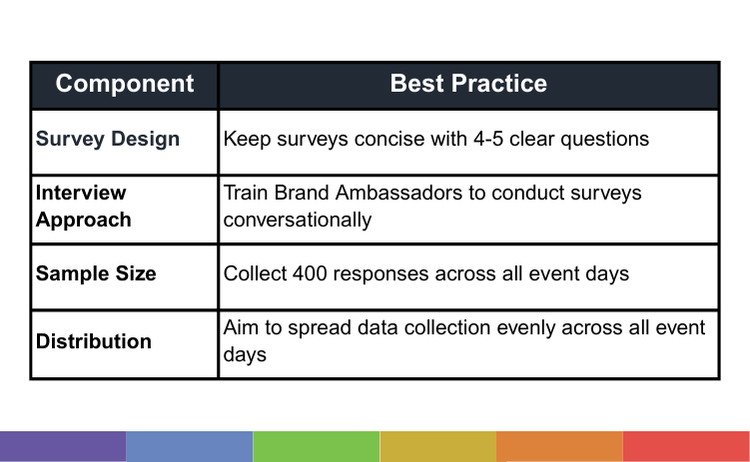
Want to make your event marketing more data-driven?
Let’s explore how you can collect consumer data during events to understand your audience better and prove your marketing success. By learning to gather the right information, you’ll be equipped to make smarter decisions and show real results.
In this article, we’ll walk you through the essential steps of effective data collection and show you how to turn that information into meaningful insights.

Download Your Free Sample Report & Benchmark Your Sponsorship ROI
See how top brands measure sponsorship success. This sample report gives you a sneak peek into industry benchmarks, helping you optimize your sponsorship strategy and justify budgets with data.
Estimated reading time: 4 minutes
Table of Contents
Why Consumer Data Collection Matters
Every consumer interaction at your event is a golden opportunity to unlock valuable insights. By capturing the right data, you’ll gain a deeper understanding of your audience’s experience, behavior, and future intentions. Here’s what well-structured data collection can reveal:
- The true scope of your activation through detailed audience profiling and engagement metrics
- Key performance indicators showing how effectively you’re guiding consumers along their purchase journey
- Clear ROI measurements by comparing your investment against tangible campaign outcomes
Without capturing these data points, you’re navigating your marketing campaigns blindfolded. These insights are crucial for transforming your strategy into a data-driven success.
Three Key Data Points to Collect
To evaluate your campaign’s success effectively, focus on collecting three core data points from event attendees:
- Demographic Profile: Identify the characteristics of your consumers to confirm alignment with your target audience.
- Past Brand Interaction: Understand attendees’ previous experiences with your brand to determine whether future behavior is incremental.
- Future Intentions: Measure their likelihood of engaging with your brand again, such as making a purchase or recommending it to others.
Collecting these data points provides a comprehensive view of your campaign’s performance and its effect on consumer behavior.
Effective Data Collection Methods
Field Staff Recaps
Field staff can provide valuable metrics at the end of each activation day, including:
- Total samples delivered
- Number of consumers engaged
- Staffing details and event timelines
These operational metrics establish a foundation for assessing overall campaign performance.
Exit Surveys
To gather deeper insights, conduct brief exit surveys with attendees as they leave your event footprint. Here are the key best practices:

This table outlines four essential components of effective event exit surveys. The concise survey design helps prevent participant fatigue, while the conversational approach integrates well with the overall activation. To ensure statistical reliability, we recommend collecting 400 responses, with even distribution across event days to capture a representative sample of attendees.
Best Practices for Success
- Consistency Matters: Ensure Brand Ambassadors maintain consistency in survey delivery.
- Simplicity Drives Participation: Avoid lengthy or overly complex surveys to maximize response rates.
- Focus on Key Metrics: Prioritize essential data points, demographics, past brand interaction, and future intentions, to keep data collection actionable.
Why Sample Size and Distribution Matter
To make confident, data-driven decisions, you need a statistically valid sample size. Here’s what you need to know:
- Statistical Confidence: 400 responses provide an acceptable margin of error for survey research.
- Comparative Analysis: If comparing subgroups (e.g., different demographics or event types), ensure each group has at least 30 responses.
Spreading data collection evenly across event days minimizes bias and ensures your results accurately represent your audience.
Take Your Event Marketing Further
Effective data collection during events doesn’t have to be complicated. By focusing on key metrics, using efficient survey techniques, and training staff appropriately, you can gather insights that empower your marketing decisions.
With consistent efforts and a clear strategy, you can measure, refine, and prove the ROI of your experiential marketing campaigns.
Start implementing these strategies today to improve your event marketing outcomes.

Download Free Sample Report Today to access comprehensive insights and boost your sponsorship ROI.
Click to Read More and Download